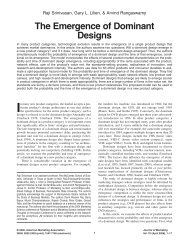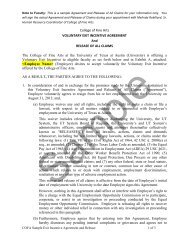Invited Talks: Transition Metal Oxides - University Blog Service - The ...
Invited Talks: Transition Metal Oxides - University Blog Service - The ...
Invited Talks: Transition Metal Oxides - University Blog Service - The ...
You also want an ePaper? Increase the reach of your titles
YUMPU automatically turns print PDFs into web optimized ePapers that Google loves.
<strong>The</strong> John B. Goodenough Symposium in Materials Science & Engineering–<br />
In Honor of His 90 th Birthday<br />
<strong>The</strong> <strong>University</strong> of Texas at Austin, Austin, Texas<br />
October 26-27, 2012<br />
Understanding Interfacial Reactivity of Silicon Nanostructures<br />
Sankaran Murugesan ± , Kjell Schroder*, Justin T. Harris + , Lauren Webb* ,± , Brian A. Korgel* ,+ and Keith J. Stevenson* , ±<br />
± Department of Chemistry & Biochemistry, + Department of Chemical Engineering, *Materials Science and<br />
Engineering Program, <strong>The</strong> <strong>University</strong> of Texas at Austin<br />
Abstract Body in Space Below:<br />
(Please use single space, Times New Roman or similar font, size 12, and limit to 250 Words. Please DO NOT exceed the space<br />
below.)<br />
In recent years Si has drawn considerable interest as an anode material for Lithium ion batteries<br />
(LIB) due to its high gravimetric and volumetric energy density. Si can react with Li and form an alloy of<br />
Li 15 Si 4 , corresponding to a very high charge storage capacity of 3579 mAh/g that is approximately 10<br />
times higher in gravimetric capacity than graphite. However, Si-based anodes face several challenges.<br />
First, crystalline Si anodes undergo a 400% volume expansion during the lithiation process. Typically<br />
large irreversible capacity losses are observed during lithiation/delithiation since volume expansion and<br />
contraction cause pulverization of the Si and loss of electrical contact with the current collector. Secondly,<br />
the electrochemical alloying potential of Si is above the solvent reduction level, which leads to the<br />
formation of a solid electrolyte interface (SEI). <strong>The</strong>se fundamental processes are investigated through high<br />
resolution spectroscopic techniques. What effects volumetric expansion/contraction processes in Si and<br />
how can they be controlled What factors govern charge transfer kinetics and how can charge transfer<br />
resistance be controlled What influence do morphology and surface chemistry have on reversibility and<br />
charge storage capacity What role does SEI play in the charge transfer process between the electrolyte<br />
and electrode
















